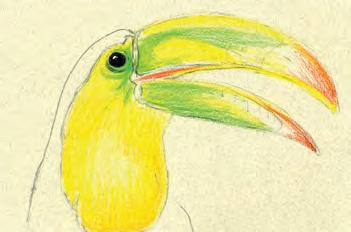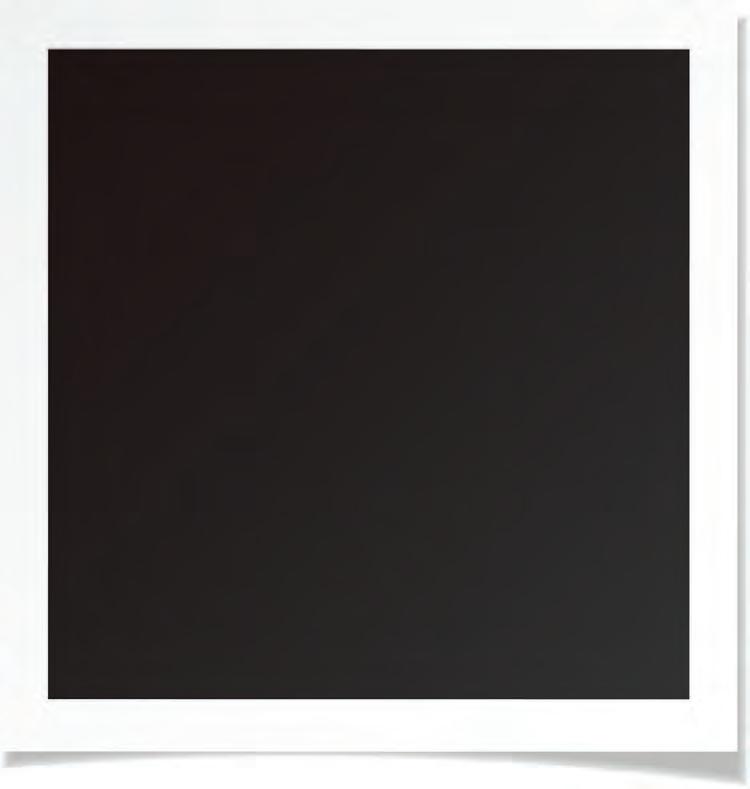
8 minute read
and Shading
Conclusion
Concluding a new book is always a bittersweet moment. The excitement and anticipation of getting to the end is a feeling of accomplishment. Knowing that all the illustrations are done and the manuscript is complete brings me such a huge sigh of relief.
Advertisement
But all of those feelings are soon replaced with the edgy anticipation of what to do next. It doesn’t take long after I complete one book before I find myself wanting create the next. I could have easily turned each chapter of this book into a book all its own. I have thousands of references of flowers, birds, and butterflies calling me to look at them, begging me to do something! Being creative leaves little time for rest or regrouping. Soon I will be starting a whole new drawing.
It may be hard to believe, but at one time I actually hated drawing with colored pencils. It's true! At the beginning, I was just doing it wrong. I had no teacher to instruct me as to how to properly apply colored pencils, so I just winged it. That didn’t work well. I became so frustrated, in fact, I almost threw them away. Instead, thank goodness, I just put them in a closet and returned to my graphite drawings. That was a technique I thought I had mastered pretty well.
But things changed. I literally woke up one day and was in the mood to try colored pencil again. And suddenly, I seemed to know what I had been doing wrong. I had no technique at all! In areas that should have been soft and layered, I was applying the pencil too heavily. In areas that should have been burnished and smooth, I was applying the pencils too lightly. Nothing came together until that day.
Once I tried colored pencils again and controlled my application, I was well on my way and learning to love them. Within a short amount of time, I had written my first book about drawing with colored pencil. It's now my favorite medium after graphite (I'll always love that the most). Don’t get frustrated, and don’t give up. It will take time and practice to learn new things. Keep practicing. Be patient. Try new approaches, and experiment with techniques and paper colors. In time, like me, you will master it!
Thank you to all who've taken the time to read this book. I hope you enjoyed the illustrations and step-by-steps. I've shared techniques that I’ve never included in a book before, and I hope you’re encouraged to try new things. The possibilities are truly endless.
Drawing is such a fun, fulfilling activity. I wish you many hours of inspiration and excitement as you pursue your artistic dreams. Thanks for taking me along on your journey. Until next time!

Memories of Mom, Prismacolor on Moonstone Artagain paper, 8" x 6". Colors used: Cream, Beige Sienna, Magenta, Process Red, Neon Orange, Chartreuse, Apple Green, Olive Green, Dark Green, Light Aqua, Black, White.
Index
A
adjacent colors 101 anhinga 106 apples 37, 42, 43, 48–49 application, controlled 20 Artagain paper 16 atmospheric perspective 123 autumn forest 68–69 autumn leaves 50 average distance 10, 41
B
backgrounds 42 balanced composition 91 bald eagles 117 Banyan trees 66–67 bees 37, 98–100 before and after drawings 7 bird of paradise flowers 86–87 birds anhinga 106 bald eagles 117 on black paper 116 bluebirds 103 blue jays 114–115 cardinals 107 colors, complementary 107 great blue herons 122–123 macaws 110–112 mourning doves 106 over the sea 124 owls 108–109 parrot feathers 104–105 pastel, adding 106 peacocks 102 robins 116, 117 sandpipers 113 seagulls 113, 124 sparrows 12 story, telling 117 surrounding details and basic shapes 103 swans 120–121 toucans 118–119 on tree limb 29 waterfowl, large 122–123 white gel pen details 120–121 black paper 16, 43, 62, 80, 94, 116 black swallowtail butterflies 92–93 bluebirds 103 blue jays 114–115 brown tones 12 brushes, drafting/makeup 17 bumblebees 98–99 burnishing 8, 18–19 butterflies approaches to drawing 95 composition and 91 fritillary 95 layering versus burnishing 19 malachite 96–97 monarch 91
Painted Lady 90 paper color and 94 red spotted purple 95 swallowtail 92–94 viceroy 91
C
cabbage leaves 64–65 caladium leaves 63 cardinals 107 cast shadows 28, 83, 84 center-based composition 91 cherry tomato 22 chrysanthemums 18, 82 circular viewfinders 38 coleuses 25 colored backgrounds 42 colors adjacent 101 color finding technique 17 complementary 27, 101, 107 cool 15 exaggerating 53 neutral 15 paper 16, 43, 62, 80, 94, 116 pencil 14–15 warm 14 white’s effect on 26 color value scales 26 color wheel 26 complementary colors 27, 101, 107 composition 25, 91 cones 29 cool colors 15 cordyline leaves 62 coreopsis 89 crabapple blossoms 73 craft knife 17 cylinders 29
D
demos apple 48–49 blue jay 114–115 bumblebee 98–99 butterfly, black swallowtail 92–93 butterfly, malachite 96–97 cherry tomato 22 egg 30
egg, colored 31 flower, bird of paradise 86–87 flower, magnolia 74–75 flower, rose 78–79 flower, waterdrops on 76–77 foliage 69 leaf, waterdrops on 56–57 orange 23 owl 108–109 parrot feathers 104–105 pears 44–45 rock 21 sea grape leaf 54–55 succulent 60–61 tomato 22, 46–47 toucan 118–119 doves 106 dragonflies 101 drawing paper 16, 43, 62, 80, 94, 116 drawings before and after 7 segment 37, 58, 96, 104, 120
E
edges 28, 32, 84 eggs 30–31 egg shape 29 erasers 17 erasing graphite lines 20
F
fixatives 17 flowers bird of paradise 86–87 blue 72 chrysanthemums 18, 82 coreopsis 89 crabapple 73 distant 88 hibiscuses 24, 81, 84 light and shadow 83–85 lilies 7, 89 lilies of the valley 33 magnolias 74–75 meadow of 88 paper colors and 80 poppies 88 roses 9–11, 37, 38, 78–81, 83, 85 shading details 82 simple and complex 73 tulips 73 viewfinders and 39 waterdrops on 76–77 white gel pens and 89 foliage 69 fruit bowls 43
fruits and vegetables apples 37, 42, 43, 48–49 backgrounds 42 lemon 29 onions 8 oranges 23 paper colors and 43 peaches 43 pears 40, 44–45 pumpkins 41 techniques 42 tomatoes 8, 22, 42, 46–47 views 41 full light 28 full view 11, 41
G
gel pens, white 17, 89, 120–121 great blue herons 122–123 grey paper 16 grid method 35
H
half tone 28 herons 122–123 hibiscuses 24, 81, 84 honey bees 37, 100
I
illustration boards 16 inspiration, finding 36
K
kneaded erasers 17 knives, craft 17
L
ladybugs 101 landscapes 37 layering 8, 18–19 leaves approaches to drawing 63–65 autumn 50 cabbage 64–65 caladium 63 colors, complementary 27 colors, exaggerating 53 cordyline 62 details 58–59 edges 32 lights and darks 52 oak 52, 53 paper colors and 62 pin oak 52 sea grape 54–55 simple and complex 64–65 succulent 60–61 vein details 51
waterdrops on 56–57 lemons 29 light 28–29, 83–85 lilies 7, 89 lilies of the valley 33 L’s (rectangular viewfinders) 36, 39
M
macaws 110–112 macro view 9, 41 magnolia 74–75 malachite butterflies 96–97 mat boards 16, 43 meadow of flowers 88 measuring 35 mechanical pencils 17 monarch butterflies 91 moths 38 mourning doves 106
N
negative space 25 neutral colors 15
O
oak leaves 52, 53 onions 8 orange 23 oval viewfinders 38 owls 108–109
P
Painted Lady butterfly 90 paper, drawing 16, 43, 62, 80, 94, 116 parrot feathers 104–105 pastel, adding 106 peaches 43 peacocks 102 pears 40, 44–45 pencil extenders 17 pencils 12–15 pencil sharpeners 17 pin oak leaves 52 plants 25, 34–35, 36. see also flowers; trees poppies 88 positive space 25 Prismacolor Premier pencils 13–15 progress 7 projects. see demos pumpkins 41
R
realism 8, 68, 84 red spotted purple butterfly 95 reflected light 28 robins 116, 117 rocks 21 roses 9–11, 37, 38, 78–81, 83, 85
S
sandpiper 113 scratching technique 67, 68–69 S-curve composition 25 sea grape leaves 54–55 seagulls 113, 124 segment drawings 37, 58, 96, 104, 120 shading 82 shadow edges 28, 84 shadows 28–29, 83–85 shapes 28–29 sparrows 12 spheres 28, 29 squash 41 standard view 10, 41 Stonehenge paper 16 storytelling 41, 117 succulent leaves 60–61 super close-up view 41 swallowtail butterflies 92–94 swans 120–121
T
tomatoes 8, 22, 42, 46–47 toned paper 16, 43 tools 12–17 toucans 118–119 transitions, smooth 20 trees 66–71, 123 tulips 73
V
vegetables. see fruits and vegetables viceroy butterfly 91 viewfinders 36, 38–39 viewpoint 9–11, 41 vines 34–35 vinyl stick erasers 17 V’s (V-shaped areas) 59, 82
W
warm colors 14 waterdrops 56–57, 76–77 waterfowl, large 122–123 white, effect on color 26 white backgrounds 42 white gel pens 17, 89, 120–121 white paper 16, 62, 80, 94
Draw colorful nature subjects with bestselling author Lee Hammond!




This book is loaded with fun lessons and projects for drawing realistic leaves, trees, flowers, butterflies, bees, birds, fruits and vegetables. It includes basic instruction on materials, transferring reference images, values, color, shadows, layering, burnishing, and other key lessons for beginners. More than 20 step-by-step demonstrations show how to draw subjects from three different viewpoints, from far away to super close.

• Get started with easily available and affordable colored pencils • Learn from top author Lee Hammond—more than one million art-instruction books sold
$28.99 US • $43.50 CAN$22.99 US • $29.99 CAN ISBN 978-1-68462-044-9 ISBN 978-1-68462-044-9
5 2 2 9 9





